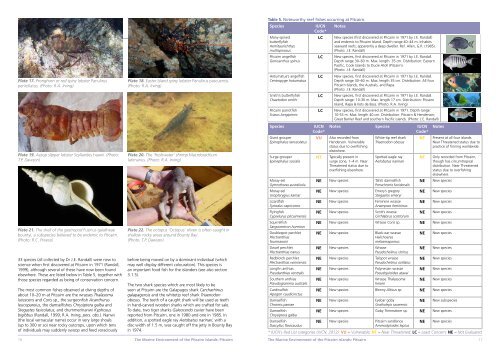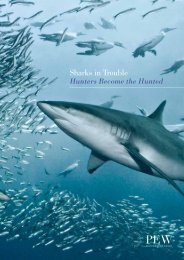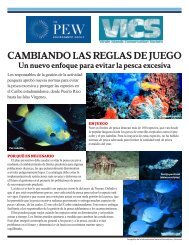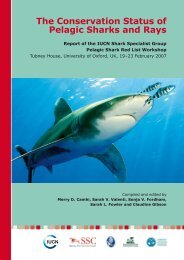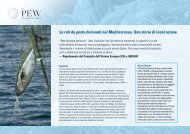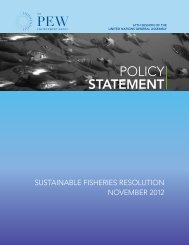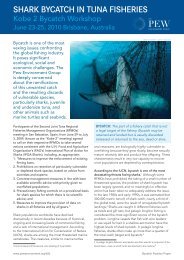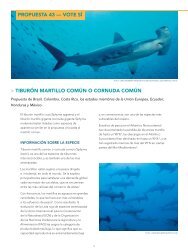The Marine Environment of the Pitcairn Islands - Pew Environment ...
The Marine Environment of the Pitcairn Islands - Pew Environment ...
The Marine Environment of the Pitcairn Islands - Pew Environment ...
Create successful ePaper yourself
Turn your PDF publications into a flip-book with our unique Google optimized e-Paper software.
Plate 17. Pronghorn or red spiny lobster Panulirus<br />
penicillatus. (Photo: R.A. Irving)<br />
Plate 19. Aesop slipper lobster Scyllarides haanii. (Photo:<br />
T.P. Dawson)<br />
Plate 21. <strong>The</strong> shell <strong>of</strong> <strong>the</strong> gastropod Fusinus gala<strong>the</strong>ae<br />
bountyi, a subspecies believed to be endemic to <strong>Pitcairn</strong>.<br />
(Photo: R.C. Preece)<br />
33 species (all collected by Dr J.E. Randall) were new to<br />
science when first discovered at <strong>Pitcairn</strong> in 1971 (Randall,<br />
1999), although several <strong>of</strong> <strong>the</strong>se have now been found<br />
elsewhere. <strong>The</strong>se are listed below in Table 5, toge<strong>the</strong>r with<br />
those species regarded as being <strong>of</strong> conservation concern.<br />
<strong>The</strong> most common fishes observed at diving depths <strong>of</strong><br />
about 10–20 m at <strong>Pitcairn</strong> are <strong>the</strong> wrasses Thalasoma<br />
lutescens and Coris sp., <strong>the</strong> surgeonfish Acanthurus<br />
leucopareius, <strong>the</strong> damselfishes Chrysiptera galba and<br />
Stegastes fasicolatus, and drummer/nanwi Kyphosus<br />
bigibbus (Randall, 1999; R.A. Irving, pers. obs.). Nanwi<br />
(<strong>the</strong> local vernacular name) occur in very large shoals<br />
(up to 300 or so) near rocky outcrops, upon which tens<br />
<strong>of</strong> individuals may suddenly swoop and feed voraciously<br />
Plate 18. Easter Island spiny lobster Panulirus pascuensis.<br />
(Photo: R.A. Irving)<br />
Plate 20. <strong>The</strong> ‘freshwater’ shrimp Macrobrachium<br />
latimanus. (Photo: R.A. Irving)<br />
Plate 22. <strong>The</strong> octopus ‘Octopus’ oliveri is <strong>of</strong>ten caught in<br />
shallow rocky areas around Bounty Bay.<br />
(Photo: T.P. Dawson)<br />
before being moved on by a dominant individual (which<br />
may well display different colouration). This species is<br />
an important food fish for <strong>the</strong> islanders (see also section<br />
3.1.5).<br />
<strong>The</strong> two shark species which are most likely to be<br />
seen at <strong>Pitcairn</strong> are <strong>the</strong> Galapagos shark Carcharhinus<br />
galapagensis and <strong>the</strong> whitetip reef shark Triaenodon<br />
obesus. <strong>The</strong> teeth <strong>of</strong> a caught shark will be used as teeth<br />
in hand-carved wooden sharks which are crafted for sale.<br />
To date, two tiger sharks Galeocerdo cuvier have been<br />
reported from <strong>Pitcairn</strong>, one in 1980 and one in 1985. In<br />
addition, a spotted eagle ray Aetobatus narinari, with a<br />
disc width <strong>of</strong> 1.5 m, was caught <strong>of</strong>f <strong>the</strong> jetty in Bounty Bay<br />
in 1974.<br />
Table 5. Noteworthy reef fishes occurring at <strong>Pitcairn</strong>.<br />
Species IUCN<br />
Code*<br />
Notes<br />
Many-spined<br />
butterflyfish<br />
Hemitaurichthys<br />
multispinosus<br />
<strong>Pitcairn</strong> angelfish<br />
Genicanthus spinus<br />
Hotumatua’s angelfish<br />
Centropyge hotumatua<br />
Smith’s butterflyfish<br />
Chaetodon smithi<br />
<strong>Pitcairn</strong> parrotfish<br />
Scarus longipinnis<br />
Species IUCN<br />
Code*<br />
Giant grouper<br />
Epinephalus lanceolatus<br />
Surge grouper<br />
Epinephalus socialis<br />
Moray eel<br />
Gymnothorax australicola<br />
Moray eel<br />
Uropterygius kamar<br />
Lizardfish<br />
Synodus capricornis<br />
Flyingfish<br />
Cypselurus pitcairnensis<br />
Squirrelfish<br />
Sargocentron hormion<br />
Doublespot perchlet<br />
Plectranthias<br />
fourmanoiri<br />
Dwarf perchlet<br />
Plectranthias nanus<br />
Redblotch perchlet<br />
Plectranthias winniensis<br />
Longfin anthias<br />
Pseudanthias ventralis<br />
Sou<strong>the</strong>rn anthias<br />
Pseudogramma australis<br />
Cardinalfish<br />
Apogon caudicinctus<br />
Damselfish<br />
Chromis pamae<br />
Damselfish<br />
Chrysiptera galba<br />
Damselfish<br />
Dascyllus flavicaudus<br />
16 <strong>The</strong> <strong>Marine</strong> <strong>Environment</strong> <strong>of</strong> <strong>the</strong> <strong>Pitcairn</strong> <strong>Islands</strong>: <strong>Pitcairn</strong><br />
<strong>The</strong> <strong>Marine</strong> <strong>Environment</strong> <strong>of</strong> <strong>the</strong> <strong>Pitcairn</strong> <strong>Islands</strong>: <strong>Pitcairn</strong><br />
LC New species (first discovered at <strong>Pitcairn</strong> in 1971 by J.E. Randall)<br />
and endemic to <strong>Pitcairn</strong> Island. Depth range 40–44 m. Inhabits<br />
seaward reefs; apparently a deep dweller. Ref. Allen, G.R. (1985).<br />
(Photo: J.E. Randall)<br />
LC New species, first discovered at <strong>Pitcairn</strong> in 1971 by J.E. Randall.<br />
Depth range 30–60 m. Max. length: 35 cm. Distribution: Eastern<br />
Pacific, Cook <strong>Islands</strong> to Ducie Atoll (<strong>Pitcairn</strong>).<br />
(Photo: J.E. Randall)<br />
LC New species, first discovered at <strong>Pitcairn</strong> in 1971 by J.E. Randall.<br />
Depth range 30–60 m. Max. length 35 cm. Distribution: All four<br />
<strong>Pitcairn</strong> <strong>Islands</strong>, <strong>the</strong> Australs, and Rapa.<br />
(Photo: J.E. Randall)<br />
LC New species, first discovered at <strong>Pitcairn</strong> in 1971 by J.E. Randall.<br />
Depth range: 10-30 m. Max. length 17 cm. Distribution: <strong>Pitcairn</strong><br />
Island, Rapa & Ilots de Bass. (Photo: R.A. Irving)<br />
LC New species, first discovered at <strong>Pitcairn</strong> in 1971. Depth range:<br />
10-55 m. Max. length 40 cm. Distribution: <strong>Pitcairn</strong> & Henderson;<br />
Great Barrier Reef and sou<strong>the</strong>rn Pacific islands. (Photo: J.E. Randall)<br />
Notes Species IUCN<br />
Code*<br />
VU Also recorded from<br />
Henderson. Vulnerable<br />
status due to overfishing<br />
elsewhere.<br />
NT Typically present in<br />
surge zone, 1–4 m. Near<br />
Threatened status due to<br />
overfishing elsewhere.<br />
White-tip reef shark<br />
Triaenodon obesus<br />
Spotted eagle ray<br />
Aetobatus narinari<br />
NE New species Tahiti damselfish<br />
Pomachromis fuscidorsalis<br />
NE New species Emery’s gregory<br />
Stegastes emeryi<br />
NE New species Feminine wrasse<br />
Anampses femininus<br />
NE New species Scott’s wrasse<br />
Cirrhlabrus scottorum<br />
Notes<br />
NT Present at all four islands.<br />
Near Threatened status due to<br />
practice <strong>of</strong> finning worldwide.<br />
NT Only recorded from <strong>Pitcairn</strong>,<br />
though has circumtropical<br />
distribution. Near Threatened<br />
status due to overfishing<br />
elsewhere.<br />
NE New species<br />
NE New species<br />
NE New species<br />
NE New species<br />
NE New species Wrasse Coris sp. NE New species<br />
NE New species Black-ear wrasse<br />
Halichoeres<br />
melasmapomus<br />
NE New species<br />
NE New species Wrasse<br />
Pseudocheilinus citrinus<br />
NE New species<br />
NE New species Tailspot wrasse<br />
Pseudocheilinus ocellatus<br />
NE New species<br />
NE New species Polynesian wrasse<br />
Pseudojuloides atavai<br />
NE New species<br />
NE New species Wrasse Thalassoma<br />
heiseri<br />
NE New species<br />
NE New species Blenny Alticus sp. NE New species<br />
NE New species Eyebar goby<br />
Gnatholepis cauerensis<br />
NE New subspecies<br />
NE New species Goby Trimmatom sp. NE New species<br />
NE New species <strong>Pitcairn</strong> sandlance<br />
Ammodytoides leptus<br />
NE New species<br />
* IUCN’s Red List categories (IUCN, 2012): VU = Vulnerable; NT = Near Threatened; LC = Least Concern; NE = Not Evaluated<br />
17


